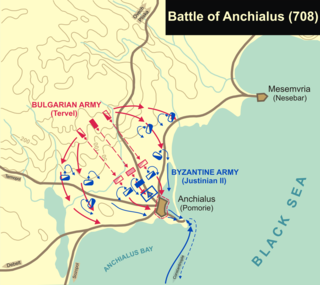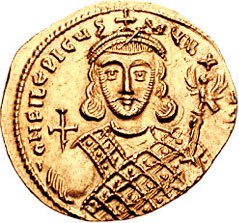 W
WThe Twenty Years' Anarchy is a historiographic term used by some modern scholars for the period of acute internal instability in the Byzantine Empire marked by the rapid succession of several emperors to the throne between the first deposition of Justinian II in 695 and the ascent of Leo III the Isaurian to the throne in 717, marking the beginning of the Isaurian dynasty.
 W
WAnastasios II or Anastasius II was the Byzantine emperor from 713 to 715.
 W
WThe Battle of Anchialus occurred in 708 AD near the modern-day town of Pomorie, Bulgaria 42°33′N 27°39′E.
 W
WPhilippikos or Philippicus was the Byzantine emperor from 711 to 713.
 W
WJustinian II, surnamed Rhinotmetos or Rhinotmetus, was the last Byzantine emperor of the Heraclian dynasty, reigning from 685 to 695 and again from 705 to 711. Like Justinian I, Justinian II was an ambitious and passionate ruler who was keen to restore the Roman Empire to its former glories, but he responded brutally to any opposition to his will and lacked the finesse of his father, Constantine IV. Consequently, he generated enormous opposition to his reign, resulting in his deposition in 695 in a popular uprising, and he only returned to the throne in 705 with the help of a Bulgar and Slav army. His second reign was even more despotic than the first, and it too saw his eventual overthrow in 711, abandoned by his army who turned on him before killing him.
 W
WKyros or Cyrus, Ecumenical Patriarch of Constantinople from 705 to 712. He is regarded as a saint in the Eastern Orthodox Church and Roman Catholic Church, which had set his feast for January 7 in Roman Catholic Church and January 8 (21) in Orthodox Church. Cyrus was placed on the patriarchal throne in 705 by Emperor Justinian II, as a replacement for the deposed Patriarch Callinicus I. Soon after Justinian's decline and eventual fall in December 711, Kyros was replaced by the new Emperor Philippicus with Patriarch John VI, who shared Philippicus' Monothelite sympathies.
 W
WLeontios or Leontius was Byzantine emperor from 695 to 698. Little is known of his early life, other than that he was born in Isauria in Asia Minor. He was given the title of patrikios, and made strategos of the Anatolic Theme under Emperor Constantine IV. He led forces against the Umayyads during the early years of Justinian II's reign, securing victory and forcing the Umayyad caliph, Abd al-Malik ibn Marwan, to sue for peace.
 W
WTheodosius III or Theodosios III was Byzantine emperor from c. May 715 to 25 March 717. Before rising to power and seizing the throne of the Byzantine Empire, he was a tax collector in Adramyttium. In 715, the Byzantine Navy and the troops of the Opsician Theme revolted against Byzantine Emperor Anastasios II, acclaiming the reluctant Theodosius as Emperor Theodosius III. Theodosius led his troops to Chrysopolis and then Constantinople, the capital, seizing the city in November 715. Anastasios did not surrender until several months later, accepting exile into the monastery in return for safety. Many themes refused to recognize the legitimacy of Theodosius, believing him to be a puppet of the troops of the Opsician theme, especially the Anatolics and the Armeniacs under their respective strategoi (generals) Leo the Isaurian and Artabasdos.
 W
WTiberius III was Byzantine emperor from 15 February 698 to 10 July or 21 August 705 AD. Little is known about his early life, other than that he was droungarios, a mid-level commander, of the Cibyrrhaeots, and that his birth name was Apsimar. In 696, Tiberius was part of an army led by John the Patrician sent by Byzantine Emperor Leontios to retake the city of Carthage in the Exarchate of Africa, which had been captured by the Arab Umayyads. After seizing the city, this army was pushed back by Umayyad reinforcements and retreated to the island of Crete; some of the officers, fearing the wrath of Leontios, killed John and declared Tiberius emperor. Tiberius swiftly gathered a fleet, sailed for Constantinople, and deposed Leontios. Tiberius did not attempt to retake Byzantine Africa from the Umayyads, but campaigned against them along the eastern border with some success. In 705 former Emperor Justinian II, who had been deposed by Leontios, led an army of Slavs and Bulgars to Constantinople, and after entering the city secretly, deposed Tiberius. Tiberius fled to Bithynia, but was captured several months later and beheaded between August 705 and February 706. His body was initially thrown into the sea, but was later recovered and buried in a church on the island of Prote.
 W
WTiberius, sometimes enumerated as Tiberius IV, was the son of Emperor Justinian II and Theodora of Khazaria. He served as co-emperor of the Byzantine Empire with his father Justinian II, from 706–711. Both were killed in 711, when Bardanes led a rebellion which marched on Constantinople. After Tiberius' death, two different individuals impersonated him, with one, named Bashir, going on to be hosted by Hisham ibn Abd al-Malik, the Umayyad caliph, before his lie was discovered and he was crucified.